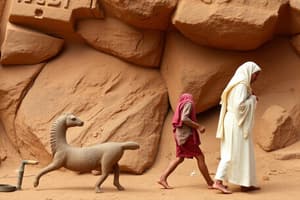Podcast
Questions and Answers
What is the main physical difference in skull shapes between early humans and modern humans?
What is the main physical difference in skull shapes between early humans and modern humans?
- Early humans had faces that protruded forward, with larger brow ridges and less pronounced chins. (correct)
- Both early and modern humans had similar skull shapes.
- Modern humans had faces that protruded forward, with larger brow ridges and less pronounced chins.
- Early humans had flatter faces, less prominent foreheads, and receding chins.
What was the average cranial capacity of early humans compared to modern humans?
What was the average cranial capacity of early humans compared to modern humans?
- Both early and modern humans had an average cranial capacity of around 1,000 cc.
- Early humans had an average cranial capacity of around 875 cubic centimeters, while modern humans had approximately 900 cc.
- Early humans had an average cranial capacity of around 875 cubic centimeters, while modern humans had approximately 1,400 cc. (correct)
- Early humans had an average cranial capacity of around 1,400 cubic centimeters, while modern humans had approximately 875 cc.
What facilitated the facial structure changes in modern humans compared to early humans?
What facilitated the facial structure changes in modern humans compared to early humans?
- Changes in diet and tool usage allowed modern humans to process softer foods with flat teeth and grinders. (correct)
- Cultural advancements were responsible for the facial structure changes in modern humans.
- The adoption of a nomadic lifestyle led to changes in the facial structure of modern humans.
- The use of advanced communication systems helped modern humans develop their facial structure.
Which era showed a greater emphasis on grinding rather than tearing food due to muscle orientation for chewing?
Which era showed a greater emphasis on grinding rather than tearing food due to muscle orientation for chewing?
What was the main reason for the larger brain sizes in modern humans compared to early humans?
What was the main reason for the larger brain sizes in modern humans compared to early humans?
What is one limitation of early humans, as mentioned in the text?
What is one limitation of early humans, as mentioned in the text?
Which cognitive ability is associated with modern humans, as per the text?
Which cognitive ability is associated with modern humans, as per the text?
What was a significant advancement of early humans in terms of technology development?
What was a significant advancement of early humans in terms of technology development?
How did artistic expression evolve in modern humans as compared to early humans?
How did artistic expression evolve in modern humans as compared to early humans?
What purpose did the cave paintings of early humans mainly serve, according to the text?
What purpose did the cave paintings of early humans mainly serve, according to the text?
Study Notes
Early and Modern Man: A Comparison of Physical Characteristics, Cultural Advancements, Art, and Symbolism
Human history can be broadly divided into two main periods: early human or prehistoric humans (from approximately 5 million years ago) and modern humans (around 60,000 years ago). Both eras have distinct physical characteristics, cultural achievements, artistic expressions, and forms of symbolic communication. In this article, we will explore these aspects of early and modern man.
Physical Characteristics
Physical differences between early and modern humans are most evident in their skull shapes:
Early Humans
Early humans had an average cranial capacity of around 875 cubic centimeters and were characterized by smaller brains relative to body size compared to modern humans. Their faces protruded forward more than those of modern humans, which included a larger brow ridge and less pronounced chin. This was due to the orientation of muscles used for chewing, which required an emphasis on grinding rather than tearing food.
Modern Humans
Modern humans, with their large brain sizes ranging from 900 - 1,600 cubic centimeters (average cranial capacity is 1,400 cc), exhibit a different facial structure. They have flatter faces, less prominent foreheads, and receding chins. These features were facilitated by changes in diet and tool usage, allowing them to process softer foods with flat teeth and grinders.
Cultural Advancements
While both ancient and recent cultures have shown remarkable progress, each period has its unique setbacks and limitations imposed by the technological capabilities available during that time:
Early Humans
Prehistorically, humans began using stone tools such as hand axes and scrapers around 2.6 million years ago, demonstrating early signs of technology. However, they lacked sophisticated languages, writing systems, advanced mathematics, complex engineering structures, and even knowledge of diseases like measles. Despite these limits, early humans developed various techniques for hunting, gathering, fishing, clothing, sheltering, and tool production.
Modern Humans
Advanced cultures emerged with the development of agriculture, pottery, metalworking, trade networks, irrigation systems, and domestication. With increased mobility and the ability to store resources, societies grew in scale and complexity. Notably, our species successfully colonized almost every landmass on Earth, including some challenging environments, leading to diverse cultural practices and beliefs across regions. Additionally, modern individuals possess a range of cognitive abilities associated with intelligence, creativity, abstract thinking, self-awareness, and imagination, allowing us to develop complex social structures, create elaborate technologies, and produce profound works of literature, music, and visual arts.
Art and Symbolism
Artistic expression has been central to human culture throughout history, evolving alongside our understanding of symbols and their meanings:
Early Humans
The first known examples of cave paintings appeared around 30,000 BC, mainly consisting of animals depicted using simple lines. These images likely served multiple purposes, such as recording experiences, portraying religious or magical ideas, conveying information about animals important for survival, and enhancing or maintaining social bonds. Without written language, proto-human communities relied heavily on mnemonic devices in the form of storytelling, songs, dances, and other dramatic performances to convey stories and transmit knowledge.
Modern Humans
With languages developing over tens of thousands of years, humans gained the power of abstraction through verbal and nonverbal methods. For instance, we can describe events without experiencing them firsthand because of shared concepts communicated via spoken and written word. Our ability to represent reality symbolically allows us to express emotions beyond basic needs, telling intricate narratives and engaging in logical reasoning. Thus, while both early and modern humans employed art and symbolism, only modern humans could convey abstract concepts and complex thoughts through graphic representation and oral tradition.
In conclusion, early and modern humans differ significantly in terms of physical traits, cultural achievements, and modes of expression. While early humans laid the groundwork for many of humanity's accomplishments, it was modern humans who were capable of leaps in intellectual growth, innovation, and refinement of society, making today's world vastly different from what existed millions of years ago.
Studying That Suits You
Use AI to generate personalized quizzes and flashcards to suit your learning preferences.
Description
Explore the differences between early and modern humans in terms of physical characteristics, cultural advancements, art, and symbolism. Learn about the unique traits and achievements that define each era, shaping the course of human history.




